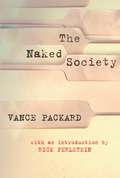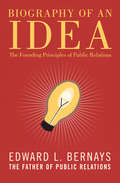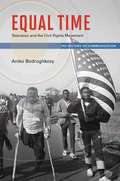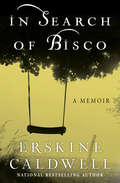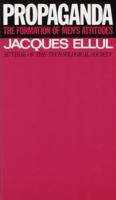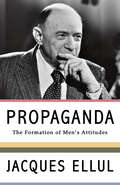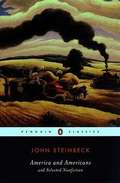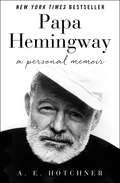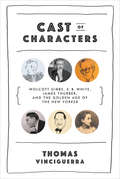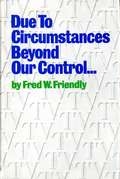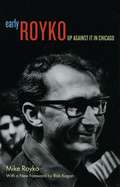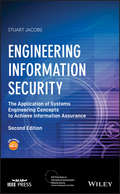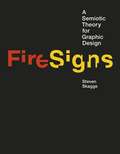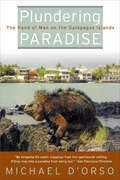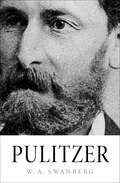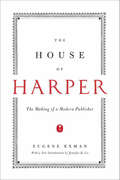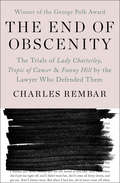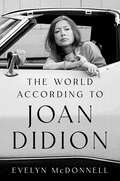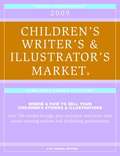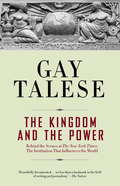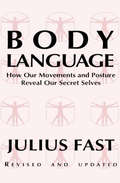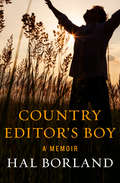- Table View
- List View
The Naked Society
by Rick Perlstein Vance PackardOriginally published in 1964, The Naked Society was the first book on the threats to privacy posed by new technologies such as modern surveillance techniques and methods for influencing human behavior. This all new edition of the book features an introduction by noted historian Rick Perlstein.
Biography of an Idea: The Founding Principles of Public Relations
by Edward L. BernaysThe father of public relations looks back on a landmark life spent shaping trends, preferences, and general opinion A twentieth-century marketing visionary, Edward L. Bernays brilliantly combined mastery of the social sciences with a keen understanding of human psychology to become one of his generation's most influential social architects. In Biography of an Idea, Bernays traces the formative moments of his career, from his time in the Woodrow Wilson administration as one of the nation's key wartime propagandists to his consultancy for such corporate giants as Procter & Gamble, General Electric, and Dodge Motors. While working with the American Tobacco Company, Bernays launched his now-infamous Lucky Strike campaign, which effectively ended the long-standing taboo against women smoking in public. With his vast knowledge of the psychology of the masses, Bernays was in great demand, advising high-profile officials and counseling the tastemakers of his generation. His masterful and at times manipulative techniques had longstanding influences on social and political beliefs as well as on cultural trends. Biography of an Idea is a fascinating look at the birth of public relations--an industry that continues to hold sway over American society.
Equal Time: Television and the Civil Rights Movement
by Aniko BodroghkozyEqual Time: Television and the Civil Rights Movement explores the crucial role of network television in reconfiguring new attitudes in race relations during the civil rights movement. Due to widespread coverage, the civil rights revolution quickly became the United States' first televised major domestic news story. This important medium unmistakably influenced the ongoing movement for African American empowerment, desegregation, and equality. Aniko Bodroghkozy brings to the foreground network news treatment of now-famous civil rights events including the 1965 Selma voting rights campaign, integration riots at the University of Mississippi, and the March on Washington, including Martin Luther King's "I Have a Dream" speech. She also examines the most high-profile and controversial television series of the era to feature African American actors--East Side/West Side, Julia, and Good Times--to reveal how entertainment programmers sought to represent a rapidly shifting consensus on what "blackness" and "whiteness" meant and how they now fit together.
In Search of Bisco: A Memoir
by Erskine CaldwellIn this travelogue and memoir, groundbreaking novelist Erskine Caldwell looks back at a life lived in the troubled South Five decades removed from his own Southern childhood, novelist Erskine Caldwell sets out on a journey to find an old friend—a friend lost to him through the culture of segregation. As Caldwell follows a trail through Georgia, South Carolina, and much of the Deep South in search of his black childhood friend Bisco, his interviews with white and black Americans expose a range of attitudes that are tragic, if not surprising. Published first in the mid-1960s just as the South was undergoing a radical transformation by freedom marches and sit-ins, In Search of Bisco offers a heartfelt account of the civil rights movement by one of the region&’s fiercest critics and most prominent sons. This ebook features an illustrated biography of Erskine Caldwell including rare photos and never-before-seen documents courtesy of the Dartmouth College Library.
Propaganda: The Formation of Men's Attitudes
by Jacques EllulJacques Ellul's view of propaganda and his approach to the study of propaganda are new. The principal difference between his thought edifice and most other literature on propaganda is that Ellul regards propaganda as a sociological phenomenon rather than as something made by certain people for certain purposes.
Propaganda: The Formation of Men's Attitudes
by Jacques EllulThis seminal study and critique of propaganda from one of the greatest French philosophers of the 20th century is as relevant today as when it was first published in 1962. Taking not only a psychological approach, but a sociological approach as well, Ellul&’s book outlines the taxonomy for propaganda, and ultimately, it&’s destructive nature towards democracy. Drawing from his own experiences fighting for the French resistance against the Vichy regime, Ellul offers a unique insight into the propaganda machine.
America and Americans and Selected Nonfiction
by John Steinbeck Susan Shillinglaw Jackson J. BensonMore than four decades after his death, John Steinbeck remains one of the nation's most beloved authors. Yet few know of his career as a journalist who covered world events from the Great Depression to Vietnam. Now, this distinctive collection offers a portrait of the artist as citizen, deeply engaged in the world around him. In addition to the complete text of Steinbeck's last published book, America and Americans, this volume brings together for the first time more than fifty of Steinbeck's finest essays and journalistic pieces on Salinas, Sag Harbor, Arthur Miller, Woody Guthrie, the Vietnam War and more. This edition is edited by Steinbeck scholar Susan Shillinglaw and Steinbeck biographer Jackson J. Benson. .
Joseph Pulitzer: and the New York World
by George JuergensTo determine how and why Pulitzer turned the unsuccessful New York World into the most widely read and probably the most prosperous newspaper in the country, Professor Juergens isolates and analyzes the special qualities of Pulitzer's new style of journalism.
Papa Hemingway: A Personal Memoir
by A. E. HotchnerAn intimate, joy-filled portrait and New York Times bestseller, written by one of Hemingway’s closest friends: “It is hard to imagine a better biography” (Life). In 1948, A. E. Hotchner went to Cuba to ask Ernest Hemingway to write an article on “The Future of Literature” for Cosmopolitan magazine. The article never materialized, but from that first meeting at the El Floridita bar in Havana until Hemingway’s death in 1961, Hotchner and the Nobel and Pulitzer Prize–winning author developed a deep and abiding friendship. They caroused in New York City and Rome, ran with the bulls in Pamplona, hunted in Idaho, and fished the waters off Cuba. Every time they got together, Hemingway held forth on an astonishing variety of subjects, from the art of the perfect daiquiri to Paris in the 1920s to his boyhood in Oak Park, Illinois. Thankfully, Hotchner took it all down. Papa Hemingway provides fascinating details about Hemingway’s daily routine, including the German army belt he wore and his habit of writing descriptive passages in longhand and dialogue on a typewriter, and documents his memories of Gertrude Stein, F. Scott Fitzgerald, Martha Gellhorn, Marlene Dietrich, and many of the twentieth century’s most notable artists and celebrities. In the literary icon’s final years, as his poor health began to affect his work, Hotchner tenderly and honestly portrays Hemingway’s valiant attempts to beat back the depression that would lead him to take his own life. Deeply compassionate and highly entertaining, this “remarkable” New York Times bestseller “makes Hemingway live for us as nothing else has done” (The Wall Street Journal).
Cast of Characters: Wolcott Gibbs, E. B. White, James Thurber, and the Golden Age of The New Yorker
by Thomas VinciguerraThe professional and personal lives of the pioneers of an enduring magazine. From its birth in 1925 to the early days of the Cold War, The New Yorker slowly but surely took hold as the country's most prestigious, entertaining, and informative general-interest periodical. In Cast of Characters, Thomas Vinciguerra paints a portrait of the magazine's cadre of charming, wisecracking, driven, troubled, brilliant writers and editors. He introduces us to Wolcott Gibbs, theater critic, all-around wit, and author of an infamous 1936 parody of Time magazine. We meet the demanding and eccentric founding editor Harold Ross, who would routinely tell his underlings, "I'm firing you because you are not a genius," and who once mailed a pair of his underwear to Walter Winchell, who had accused him of preferring to go bare-bottomed under his slacks. Joining the cast are the mercurial, blind James Thurber, a brilliant cartoonist and wildly inventive fabulist, and the enigmatic E. B. White--an incomparable prose stylist and Ross's favorite son--who married The New Yorker's formidable fiction editor, Katharine Angell. Then there is the dashing St. Clair McKelway, who was married five times and claimed to have no fewer than twelve personalities, but was nonetheless a superb reporter and managing editor alike. Many of these characters became legends in their own right, but Vinciguerra also shows how, as a group, The New Yorker's inner circle brought forth a profound transformation in how life was perceived, interpreted, written about, and published in America. Cast of Characters may be the most revealing--and entertaining--book yet about the unique personalities who built what Ross called not a magazine but a "movement."
Due to Circumstances Beyond Our Control . . .
by Fred W. FriendlyThis discourse on the importance of television in society presents Friendly's uncannily prescient views on the corrosive effect of money on the news business, the sensationalization of news reporting, and the viewing public's appetite for quality broadcasting. With Edward R. Murrow, Fred Friendly practically invented television journalism. Through telling anecdotes and penetrating analysis, he recalls his collaborations with Murrow, from their stinging documentary on Senator Joseph McCarthy to CBS's pioneering coverage of the burgeoning civil rights and anti-Vietnam War movements. Friendly also recounts his resignation as president of CBS News in 1966, when the network ran reruns of I Love Lucy instead of Senate hearings on the war in Vietnam. Following that controversial decision, he began writing this memorable book.
Early Royko: Up Against It in Chicago
by Mike RoykoCombining the incisive pen of a newspaperman and the compassionate soul of a poet, Mike Royko became a Chicago institution—in Jimmy Breslin’s words, "the best journalist of his time." Early Royko: Up Against It in Chicago will restore to print the legendary columnist’s earliest writings, which chronicle 1960s Chicago with the moral vision, ironic sense, and razor-sharp voice that would remain Royko’s trademark. This collection of early columns from the Chicago Daily News ranges from witty social commentary to politically astute satire. Some of the pieces are falling-down funny and others are tenderly nostalgic, but all display Royko’s unrivaled skill at using humor to tell truth to power. From machine politicians and gangsters to professional athletes, from well-heeled Chicagoans to down-and-out hoodlums, no one escapes Royko’s penetrating gaze—and resounding judgment. Early Royko features a memorable collection of characters, including such well-known figures as Hugh Hefner, Mayor Richard J. Daley, and Dr. Martin Luther King. But these boldfaced names are juxtaposed with Royko’s beloved lesser knowns from the streets of Chicago: Mrs. Peak, Sylvester "Two-Gun Pete" Washington, and Fats Boylermaker, who gained fame for leaning against a corner light pole from 2 a.m. Saturday until noon Sunday, when his neighborhood tavern reopened for business. Accompanied by a foreword from Rick Kogan, this new edition will delight Royko’s most ardent fans and capture the hearts of a new generation of readers. As Kogan writes, Early Royko "will remind us how a remarkable relationship began—Chicago and Royko, Royko and Chicago—and how it endures."
Engineering Information Security
by Stuart JacobsInformation security is the act of protecting information from unauthorized access, use, disclosure, disruption, modification, or destruction. This book discusses why information security is needed and how security problems can have widespread impacts. It covers the complete security lifecycle of products and services, starting with requirements and policy development and progressing through development, deployment, and operations, and concluding with decommissioning. Professionals in the sciences, engineering, and communications fields will turn to this resource to understand the many legal, technical, competitive, criminal and consumer forces and influences that are rapidly changing our information dependent society.If you're a professor and would like a copy of the solutions manual, please contact ieeepress@ieee.org.The material previously found on the CD can now be found on www.booksupport.wiley.com.
FireSigns: A Semiotic Theory for Graphic Design
by Steven SkaggsGraphic design has been an academic discipline since the post-World War II era, but it has yet to develop a coherent theoretical foundation. Instead, it proceeds through styles, genres, and imitation, drawing on sources that range from the Bauhaus to deconstructionism. In FireSigns, Steven Skaggs offers the foundation for a semiotic theory of graphic design, exploring semiotic concepts from design and studio art perspectives and offering useful conceptual tools for practicing designers.Semiotics is the study of signs and significations; graphic design creates visual signs meant to create a certain effect in the mind (a "FireSign"). Skaggs provides a network of explicit concepts and terminology for a practice that has made implicit use of semiotics without knowing it. He offers an overview of the metaphysics of visual perception and the notion of visual entities, and, drawing on the pragmatic semiotics of the philosopher Charles Sanders Peirce, looks at visual experience as a product of the action of signs. He introduces three conceptual tools for analyzing works of graphic design -- semantic profiles, the functional matrix, and the visual gamut -- that allow visual "personality types" to emerge and enable a greater understanding of the range of possibilities for visual elements. Finally, he applies these tools to specific analyses of typography.
Plundering Paradise: The Hand of Man on the Galápagos Islands
by Michael D'OrsoMention the Galápagos Islands to almost anyone, and the first things that spring to mind are iguanas, tortoises, volcanic beaches, and, of course, Charles Darwin. But there are people living there, too -- nearly 20,000 of them. A wild stew of nomads and grifters, dreamers and hermits, wealthy tour operators and desperately poor South American refugees, these inhabitants have brought crime, crowding, poaching, and pollution to the once-idyllic islands. In Plundering Paradise, Michael D'Orso explores the conflicts on land and at sea that now threaten to destroy this fabled "Eden of Evolution."
Pulitzer
by W. A. SwanbergFrom the National Book Award–winning author, an absorbing biography of the esteemed editor, publisher, power broker, and rival to William Randolph Hearst. An eccentric genius, Joseph Pulitzer immigrated to the United States to fight in the Civil War—despite barely speaking English. He would soon master the language enough to begin a successful newspaper career in St. Louis, become a fierce opponent to William Randolph Hearst, and, eventually, found the Columbia School of Journalism. A Hungarian born into poverty, Pulitzer epitomized the American Dream by building a fortune. But he also suffered: going blind in the middle of his career, experiencing extreme mood swings, and developing an intense irritability that made everyday life difficult to tolerate. In this book, W. A. Swanberg—a recipient of the prestigious prize named after Pulitzer—recounts the personal and professional life of the newspaper magnate, as well as his significant influence on American politics. Swanberg reveals how the New York World managed to balance admirably accurate reporting with popular appeal, and explores Pulitzer&’s colorful, contradictory character—courageous and self-pitying, dictatorial and generous. Set against the backdrop of a turbulent era, this is a portrait of an outsize personality by an author with a flair for both the big picture and small, fascinating detail.Includes photographs.Praise for W. A. Swanberg&’s biographies &“First-rate.&” —The New York Times on Citizen Hearst &“Engrossing.&” —Kirkus Reviews on Norman Thomas: The Last Idealist
The House of Harper: The Making of a Modern Publisher
by Eugene ExmanAn updated edition of this definitive history of Harper—a fascinating look into the history of American letters from the unique perspective of one of the country’s most distinguished and enduring publishers—now with a new introduction that brings the book up to the present day. From Moby Dick to Huckleberry Finn—but not Alice in Wonderland, which was rejected—The House of Harper is a sweeping trip through American letters, offering anecdotes and stories about authors from Charles Dickens, Herman Melville, and Mark Twain to Thomas Wolfe, Aldous Huxley, and Edna St. Vincent Millay.
The End of Obscenity: The Trials of Lady Chatterley, Tropic of Cancer & Fanny Hill by the Lawyer Who Defended Them
by Charles RembarWinner of the George Polk Award: Charles Rembar's illuminating account of overturning America's obscenity laws and protecting literature from censorship Up until the 1960s, depending on your state of residence, your copy of Henry Miller's Tropic of Cancer might be seized by the US Postal Service before reaching your mailbox. Selling copies of Cleland's Fanny Hill in your bookstore was considered illegal. Lady Chatterley's Lover by D. H. Lawrence was, according to the American legal system, pornography with no redeeming social value. Today, these novels are celebrated for their literary and historic worth. The End of Obscenity is Charles Rembar's account of successfully arguing the merits of such great works of literature in front of the Supreme Court. As the lead attorney on the case, he--with the support of a few brave publishers--changed the way Americans read and honor books, especially the controversial ones. Filled with insight from lawyers, justices, and the authors themselves, The End of Obscenity is a lively tour de force. Racy testimony and hilarious asides make Rembar's memoir not only a page-turner but also an enlightening look at the American legal system.
The World According to Joan Didion
by Evelyn McDonnell**INDIE BESTSELLER**A MOST ANTICIPATED BOOK OF 2023 by The Millions • B&N Best Books of 2023 • “Shaped by intellectual rigor and artistic grace … McDonnell’s portrait is vibrant, fluent, sensitive, and clarifying.” — Booklist, starred reviewAn intimate exploration of the life, craft, and legacy of one of the most revered and influential writers, an artist who continues to inspire fans and creatives to cultivate practices of deep attention, rigorous interrogation and beautiful style.Joan Didion was a writer’s writer; not only a groundbreaking journalist, essayist, novelist and screenwriter, but a keen observer who honed her sights on life’s telling details. Her insights continue to influence creatives and admirers, encouraging them to become close observers of the world, unsentimental critics, and meticulous stylists.An antidote to a global view that narrows our vision to the smallest screens, The World According To Joan Didion is a meditation on the people, places, and objects that propelled Didion’s prose and an invitation to journalists, storytellers, and life adventurers to “throw themselves into the convulsions of the world,” as she once said.Evelyn McDonnell, the acclaimed journalist, essayist, critic, feminist, native Californian, and university professor who regularly teaches Didion’s work, is attuned to interpret Didion’s vision for readers today. Inspired by Didion’s own words—from her works both published and unpublished—and informed by the people who knew Didion and those whose lives she shaped, The World According to Joan Didion is an illustrated journey through her life, tracing the path she carved from Sacramento, Portuguese Bend, Los Angeles, and Malibu to Manhattan, Miami, and Hawaii. McDonnell reveals the world as it was seen through Didion’s eyes and explores her work in chapters keyed to the singular physical motifs of her writing: Snake. Typewriter. Hotel. Notebook. Girl. Etc.One of the first books to be published after the revered writer’s death in 2021, The World According to Joan Didion is a literary companion for those embarking on new journeys and a guide to innovative ways of being. It will radically transform the way you explore the world, and will help you answer the question as you sit in a café, or on a plane or train, pondering the future: What would Joan Didion have seen?The World According to Joan Didion includes 19 black-and-white illustrations and photos throughout.
2009 Children's Writer's & Illustrator's Market®
by Alice PopeIf you long to see your stories or artwork in the hands of young readers--from toddlers to teens--this is the book you'll need. Our 2009 edition includes 700+ updated listings for book publishers, magazines, agents, art reps, and others who may be interested in your work. Also includes articles and interviews with National Book Award winner Sherman Alexie; best-selling authors Scott Westerfeld and Katherine Applegate, and many others including more than half a dozen new authors. Listings for organizations, conferences, workshops, contests, awards, grants and more of interest to children's writers and illustrators included. Get perspective and insight into the writing, revising, and submitting of your work, negotiating contracts, working with agents, and more. This could be the year your writing dreams comes true.
The Kingdom and the Power
by Gay TaleseThe classic inside story of The New York Times, the most prestigious, and perhaps the most powerful, of all American newspapers. Bestselling author Talese lays bare the secret internal intrigues behind the tradition of front page exposes in a story as gripping as a work of fiction and as immediate as today's headlines.From the Trade Paperback edition.
84 Charing Cross Road
by Helene HanffThis is a touching correspondence between Helene Hanff and the employees at a book shop on Charing Cross Road in London. It spans many years. Short but satisfying, this little book will warm your heart.
Body Language: The Essential Secrets Of Non-verbal Communication
by Julius FastA revised and updated edition of the New York Times–bestselling classic on understanding body language from the author of Subtext.Body Language helps you to understand the unconscious body movements and postures that provide intimate keys to what a person is really thinking and the secrets of their true inner selves. You will learn how to read the angle of shoulders, the tilt of a head, or the tap of a foot, in order to discern whether an individual is angry, frightened, or cheerful. You will be able to use Body Language to discover the most—and least—important person in any group by the way others position themselves. The body is not able to lie, for it sends subtle signals to those who know how to read them. Body Language will even show you how to do it without others knowing you are observing them. Body Language was a huge best seller when first published and has remained in print ever since. It has been thoroughly updated and revised especially for this ebook edition.
Country Editor's Boy: A Memoir
by Hal BorlandA memoir of youthful years spent in Colorado as the American West was transformed, by the author of High, Wide, and Lonesome and The Dog Who Came to Stay. Country Editor&’s Boy picks up where Hal Borland&’s classic memoir High, Wide and Lonesome left off: with Borland, on the cusp of adulthood in the early twentieth century, making his way in an eastern Colorado town that still retained all the flavors of the Old West. Borland&’s father, the editor of a local weekly newspaper, was working to help his publication transition along with the town around him. At the same time, young Hal was experiencing dramatic social and economic change in his own way. In a matter of a decade, Borland&’s Colorado town shifted from a frontier outpost to part of a rapidly urbanizing new America. This memoir shows a boy entering adulthood as the world around him comes of age. Evocative and wholly engrossing, Country Editor&’s Boy is a vividly drawn portrait of western life, by one of the greatest naturalist writers of his age.
